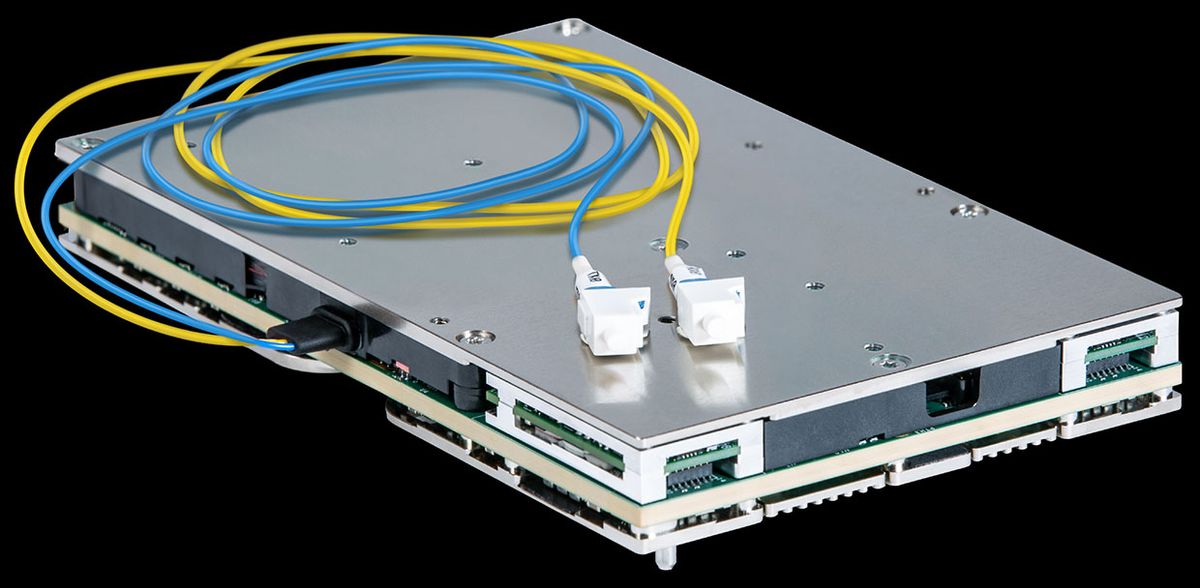Fiber-optic data rates on a single wavelength will take a big step up later this month. Acacia Communications says it will demonstrate a 1.2-terabit-per-second module at the European Conference on Optical Communications (ECOC) that is taking place from 22-26 September in Dublin. Transmission of up to 800 gigabits per second on a single wavelength was introduced for the first time this March at the Optical Fiber Communications Conference (OFC) in San Diego. Both meetings are cosponsored by IEEE.
The explosive growth of cloud computing and traffic between data centers has given network operators a tremendous thirst for bandwidth on scales including those for transmission inside data centers at the network edge and for submarine cable stretching more than 10,000 kilometers. Data centers have long relied on coherent optical transmission of 100-gigabit Ethernet signals on each of many separate wavelengths carried by an optical fiber. Now operators have begun shifting traffic at busy data centers to 400-Gigabit Ethernet. With cloud data centers now mirrored around the globe, operators also are pushing for ever-increasing capacities for transoceanic submarine cables, most recently the Pacific Light Cable capable of carrying 144 terabits per second between Hong Kong and Los Angeles.
The crucial elements of those transmission systems are modules that convert digital signals between electronic and optical forms. They require both photonic circuits that convert digital signals between electronic and optical formats, and powerful digital signal processing (DSP) chips that extract error-free signals from the noise that accumulates during high-speed transmission. In 2017, Acacia introduced its 1.2-T Pico DSP chip, which operates at 1200 gigabits per second, and later was integrated into a module that split it into a pair of 600-gigabit signals for transmission on two separate wavelengths.

Acacia’s new AC1200-SC2 module combines the DSP chip with integrated photonic circuits to generate a 1200-Gb/s signal for transmission on a single channel in a fiber. That makes the module optimizable for high speed over short distances and long distances at lower speed, says Acacia VP of marketing Tom Williams. The modules can transport three 400-GigE signals of data center traffic using the powerful but delicate 64QAM modulation scheme. For transmission over longer distances, the module can switch to more robust modulation schemes. 16QAM can carry two 400-GigE signals, and the rugged DPSK (Differential Phase Shift Key) scheme can transport one 400 GigE signal over 10,000 kilometers, as shown in the figure. The module also can be adjusted to support legacy signal formats still in wide use, where the bandwidths of a single optical channel or wavelength are 50, 75, or 100 gigahertz.
A key to further enhancements, Williams adds, is the use of silicon photonics for converting the digital signals between optical and electronic format. The strength of silicon photonics is its integration of silicon with optical materials to combine optical and electronic functions. It's a field that has matured recently, as IEEE recognized when it announced that its annual Photonics award would be given to Chris Doerr, Acacia's vice president for advanced development, for his work in the field.
The new modules “could translate to better price per bit of transmission along a fiber,” depending on how vendors price their systems, says Jimmy Yu of the market analysis firm Dell'Oro Group. In the long term, “the words ‘400 Gbps everywhere’ resonate the most,” he says. Once 800- and 1200-gigabit systems become available, network operators can for the first time transmit 400 gigabit signals on long haul and ultra-long haul routes.
Jeff Hecht writes about lasers, optics, fiber optics, electronics, and communications. Trained in engineering and a life senior member of IEEE, he enjoys figuring out how laser, optical, and electronic systems work and explaining their applications and challenges. At the moment, he’s exploring the challenges of integrating lidars, cameras, and other sensing systems with artificial intelligence in self-driving cars. He has chronicled the histories of laser weapons and fiber-optic communications and written tutorial books on lasers and fiber optics.



